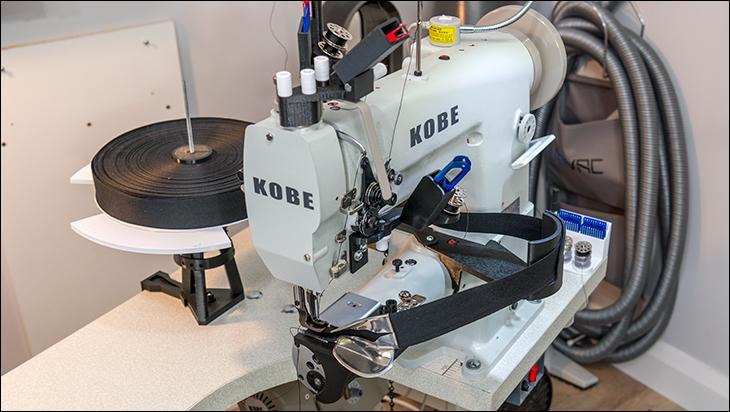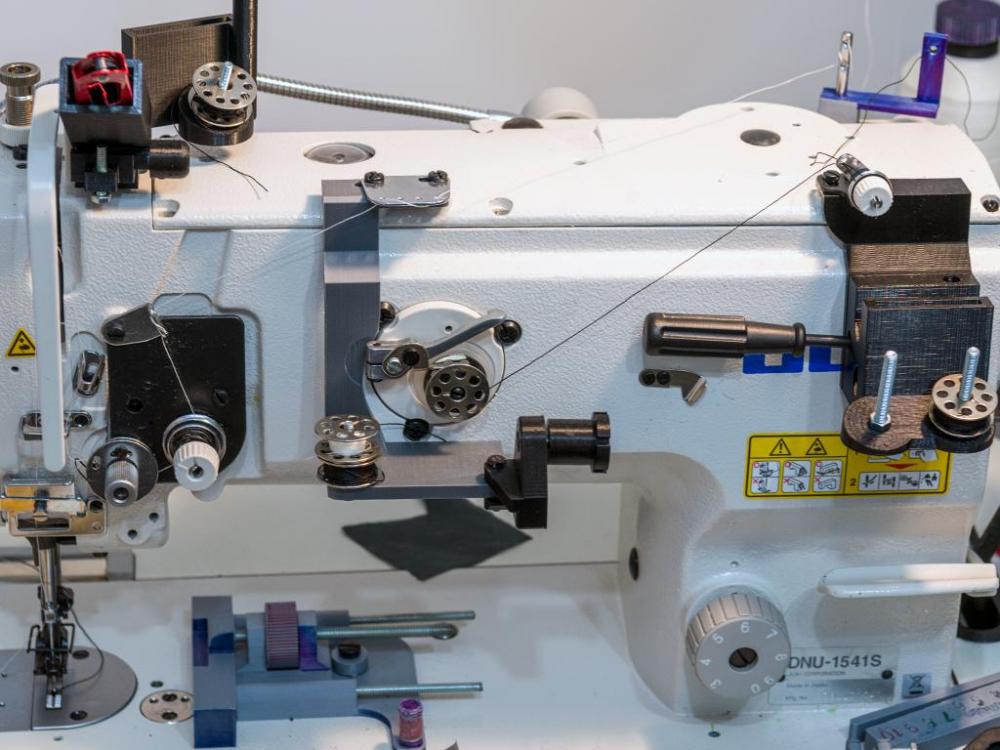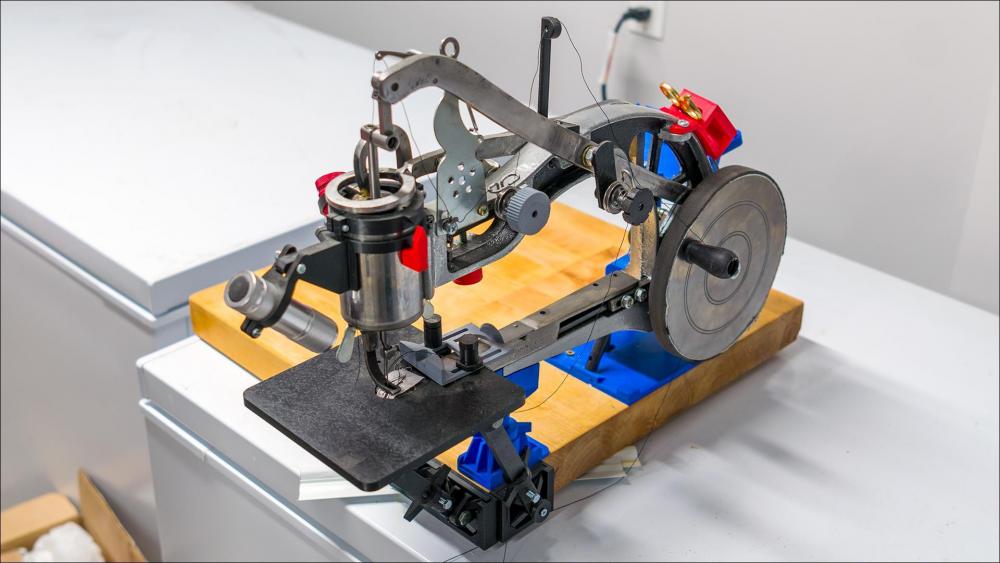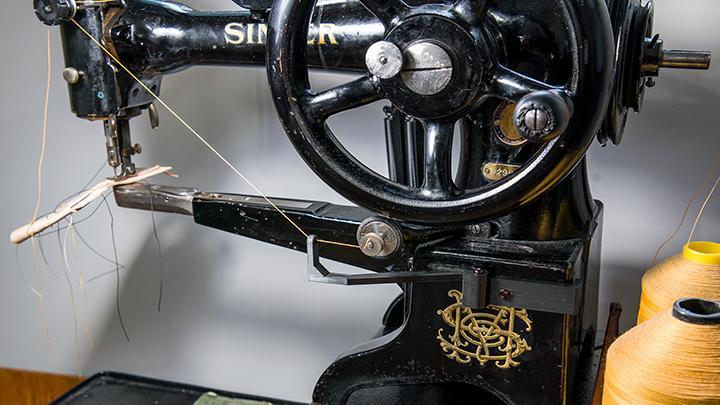
kgg
Contributing Member-
Posts
3,275 -
Joined
-
Last visited
Content Type
Profiles
Forums
Events
Blogs
Gallery
Everything posted by kgg
-
This is a high speed needle feed machine made for fabric and the max size needle is a #18 needle for a max size thread of V69. For me the major downfall with any machine having electronics is the electronics as I like to to keep my machines very basic mechanical machines. If the electronics goes out it is going to be expensive to repair, if you can get the parts. This machine is missing the pressor foot, needle feed dog, cover plate and probably more. To me the price is way over priced for a fixer upper that will not do leather. kgg
-
It is 3d printed as well as the adjustable support legs and the table attachments for it. My machines except for the Tinkers Delight live in the bedroom across from me. Those are some, not all, of the accessories / attachments that I have designed and 3D printed for my machines just to make life a little easier. My main consideration for any accessories / attachments is that there are no additional holes needed to be drilled into the table top or sewing machine. What I have shown in the photo's are: i) Kobe LS-1341 clone: turn table style binder tape dispenser with ball bear race; binder tape guides; micro table attachment to allow for the use of standard flat bed binders / edge guide; top mounted swivel bobbin/ snip holder; lower swivel bobbin / snip holder; hands free bobbin thread cutter with needle / bobbin caddy ii) Juki DNU-1541S: top mounted swivel bobbin & snip holder; lower swivel bobbin & snip holder; hands free bobbin thread cutter with needle / bobbin caddy; caddy for tools / needle / bobbins iii) Chinese Patcher a Tinkers Delight: adjustable double light caddy (front gray led light and far side red led light); pressor foot position indicator (red arrow); Red colored rear mounted scissor holder; Blue colored rear mounted 1lb bobbin thread holder; Blue colored rear mounted top thread holder; Black colored 6" drop down adjustable table top; Blue colored adjustable height nose support (prevents any forward tipping of the machines arm); Blue colored machine mounting base iv) 1949 Singer 29k-71 swing away bobbin thread guide ( replaces your finger so you can wind a bobbin as you go ); double 1lb spool holder; double spool thread guide; double thread guide for top and bobbin thread. kgg
-
The Kobe is a LS-1341 Clone, Juki DNU-1541S, Chinese Patcher (Tinkers Delight), Singer 29K-71 (1949) my Juki 1181n is setup similar to the 1541S
-
Patching a strap for yourself is at your own risk but doing it for someone else to be used in a commercial application like for a tow truck driver you could very well open yourself up to being liable should anything happen to a strap that you fixed up. The Singer 20U is a high speed drop feed machine made for light weight fabric and isn't really suited for much more. The machine was made to handle light weight threads and maxing out at V69 and a #18 needle much like your domestic sewing machines. kgg
-
I agree. My expectation of a new anything particularly a sewing machine is that it works out of the box except for minor adjustments, thread tension type stuff. Unless it is a Chinese Patcher which is a "tinkers delight" or a used machine I expect it to sew properly in forward and reverse for the needles sizes and thread sizes it is rated for. Yes, I can do some of my own repairs but not everyone wants or should be a sewing machine mechanic. If a machine requires 4 or 5 hours of adjustments before it sews properly what does that say about the initial quality control at the manufacturing level. Like the old saying "you get what you pay for" the difference that separates dealers is the level of service they can provide. I do like brand name equipment and Juki has never disappointed me, yes they are more expensive but the quality difference can be great and noticeable. I have test rode a few clones and I do admit some were good while others I would put them in the "sounded like a bucket of bolts banging around" category. kgg
-
I believe Nikos69 bought a Techsew 2750 from him about 2 years ago. You may want to drop him a PM and see what his experience was like. Also you could do a search on this forum for ---- "industrial sewing machine man”---. You should come up with something. The last two new machines I bought were a Juki and a Juki clone. I got them fresh off the boat so to speak, packages unopened. Saved the check over / setup fee. The Juki sewed perfectly out of the box while the clone needed a couple of small adjustments. kgg
-
Just a little food for thought since most everyone is cost conscious. I figured I'd see what the cost of a Singer 29k back 100 years would have cost versus the average hourly and yearly wage. What I found sort of surprised me. 1) Average 1922 hourly wage $0.35 Average yearly wage $728 for 52 weeks of work based on a 40 hour work week. Average cost of a Singer 29K was $60 which works out to about 4.28 weeks of salaried work. 2) Average 2021 hourly wage $26.78 Average yearly wage $54,630 CAD for 52 weeks of work 3) If the Singer 29K was being still made what could we expect it to cost? 4.28 weeks of work X 26.78 hourly wage X 40 hour work week = $4,584.74 CAD In Canada the cost of a new overseas 29K clone ranges in price from $1079 and $3600 while a brand name Claes Model 30 costs about $7000. kgg
-
If the cylinder bed machine is what will suit your needs why not just cut to the chase and buy either a new Juki LS-1341 or a used Juki LS-341. The Juki LS-341 is the model that the dealers you have contacted are copying. I would contact Juki USA and ask them if there is a dealer close to you as well as they would be able to answer your questions. As a price reference the cost for a new Juki LS-1341 would be about $3650 US from Industrial Sewing Machine Man ( industrialsewingmachineman.com/machines/mach.asp?dir=sewmach&brand=Juki&Model=LS%2D1341&ProductType=Industrial+Straight+Stitch+Machines ). I don't think the Juki LS-341 / 1341 or a clone is going to be the right machine for doing 1000d (I am assuming it is some form of ripstop nylon material). A simple walking foot something like a 1181n would do that much more efficiently. If you decide to buy a new machine buy a Brand Name like Juki, Adler, PFAFF. The brand name machines will hold their value better, easier to resell and command a higher resale price then a clone. Buy Once, Cry Once kgg
-
I do agree with Constabulary. I can't see how a roller foot would work. I do have some roller feet that I think may fit the shaft.
-
If you are buying new buy a Brand Name like Juki, Adler, PFAFF. The brand name machines will hold their value and command a higher resale price then a clone. If you are looking for a: i) Flatbed machine I would recommend a Juki DNU-1541S ~ $1800 US compound feed first then maybe a Juki 1181N ~ $1400 US would probably do the job but it is only a walking foot machine. ii) Cylinder Bed machine I would recommend a Juki LS-1341 ~ $3800 US iii) If space is a consideration maybe a portable walking foot machine like Sailrite LSZ-1 ~$1000 (basic model) or the Reliable Barracuda ~$600 I would still recommend you visiting a dealer with a sample of your stuff and try a couple of machines. Buy Once, Cry Once kgg
-
I think you should send those video's to DURKOPP ADLER and ask for there advice on what is happening with your thread take-up lever. kgg
-
For the price range: i) Hand operated you could also look at the one armed bandits (Tippmann Boss and Cowboy Outlaw). ii) Motor operated maybe the Reliable Barracuda would be an alternative to the Sailrite for about $600 new. iii) Used Industrial machine. kgg
-
Sorry for your loss. Even as a breeder it never gets easier nor should it. kgg
-
I would be very skeptical as this is a domestic sewing machine designed and made for fabric. kgg
-
I have a couple of suggestions: 1) Thread: i) Top thread: Change to a larger size of spool preferably a 1 lb (454 gram) spool rather then the mini (domestic machine) size spool you are using. You should find a more consistent tension of the unwinding of thread. I find having the thread entering the first guide as close to the horizontal plane as possible rather then the steep downward angle like you have really helps. ii) Bobbin thread: Do the drop test on your bobbin to ensure proper tension. 2) Thread Guides: i) At the first thread guide: rethread the first guide so the thread enters the middle hole then loop thread over the top of the guide and enter the thread from the rear of the guide through the left most hole. Also do the same for when you are winding a bobbin. This should give more of a consistent amount of thread being unwound from the spool. ii) Move your thread take up guide so it indicates a larger number, I would try position 3. iii) I would rethread the thread through the bottom hole in the takeup arm rather then the top hole. kgg
-
What size of spool of thread are you using 8 oz (~226 grams) or 1 lb (~ 453 gram) as sometimes the small sizes of thread particularly black have caused problems.Would it be possible to take a couple of photo's of your thread path from the thread spool to the needle as well as a photo of how you have the spool of top thread set up. To get thread properly coming off the spool there should be at least 2 1/2 times the height of the thread spool between the bottom of the spool platform to the spool thread guide. kgg
-
I am not overly familiar with Gutermann thread other then it is now called A&E Gütermann but if you are using: 1) a 134-35 size 120 (#19) needle you need to use a V92 ( Tex90, Tkt 30, M40, 40) thread, 2) a 134-35 size 160 (#23) needle you need to use a V138 (Tex135.Tkt 20, M20, 20) thread Your machine should be able to handle a top thread size of 15 (V207, Tex210,Tkt 15, M20, 20) with a max bobbin thread size of 20 (V138,Tex135, Tkt 20, M20, 20). A couple of good charts for what needle size to use with what thread size: 1) 5 Thread Size Comparison Chart 2-4-10 2) https://www.tolindsewmach.com/thread-chart.html Your problem maybe that you are using a needle one size up from the recommended size in thin leather so the hole maybe to large for that thread size; if you are using a polyester thread the knot may have an easier time slipping up to the top particularly during hand wheeling the stitches as the amount of needle pressure maybe not as constant as that of when the machine is motor powered. Just my thoughts. Why are you hand wheeling long seams is it because you are using a clutch motor ?? kgg
-
Definitely not pretty and by the looks of it was used in a industrial setting to have that amount of paint wear. I would go to a dealer with your stuff and look for a newer or new sewing machine before spending that amount of money for that particular machine. kgg
-
I don't think the Nakajima have been around since 1966 when Juki took them over. That is not to say it is a bad machine just based on age as there are a lot of excellent machines of that age and older still working perfectly. It will depend on how it was maintained. The price of $800 US ($1018 CAD) to me seems high. I would have a tendency to look at machines from a dealer / repair shop that has been professionally serviced / restored. Some of the things I would look for are threads paths cut into the thread guides and take up arm; clunking noises; bearing slop; amount of paint worn from the bed; rust; condition of drive gears, condition of the table top and does it sew properly. A couple of photo's maybe helpful and what are you planning on sewing? kgg
-
From the information I have seen on your machine it uses 135 x 7 in sizes from #9 to #24 as noted on page 6 of the Singer manual not 135 x 17. So if you want to use 135 x 17 needles you may very well have to retime your machine. kgg
-
Good idea. I have used a similar method on both my flatbeds and cylinder machines where I have used a rare earth magnetic on the flatbeds and a simple tight slit or seam in my table top attachment. The only drawback is that it can be a fine line between the thread holder holding the threads at the right tension. If the threads aren't held tight enough then the initial stitches will not be proper. If the threads are held too tight and if you are not careful enough to make sure they slip out of the holder it will drag the material towards and / or downward to where the holding point is. Most times it works perfectly and frees up your hand to help guide the material so you can get those first couple of stitches in. kgg
-
If you want to try a inexpensive binder I would search Amazon France for a 2" Single fold binder would. To give you a rough cost the double fold binders in 2" are available in Canada for $15.99. CKPSMS brand - 1SET #KP-123 Sewing Machine Double Fold Clean Finish Top & Bottom Binding Binder Attachment (Tape Size 2" =50MM) Amazon.ca ( https://www.amazon.ca/gp/product/B07RTJZMK3/ref=ppx_yo_dt_b_search_asin_title?ie=UTF8&th=1 ) Another option is if you know someone with a 3D printer they should be able to print you one if you can't find one. kgg
-
Finding reviews / video's / capabilities / specs of industrial sewing machines in general are pretty much left up to the individual dealers to provide whereas if you were looking for a domestic sewing machine there are many sites that do sort of side by side comparisons of different manufacturers machines. I guess the leather part of the industry is just too small / specialized area in the overall scheme of things. Also not every dealer / distributor has the expertise / want to provide the same level of information as the Sailrite site. kgg
-
Welcome to the forum. There are a couple of options. If you a using a single fold binder you maybe able to pry it open slight to get some extra thickness of material through the binder, have a custom binder made which is going to be expensive or adapt a cover stitch binder to work on your machine sort of like what this person done ( https://www.youtube.com/watch?v=YF04w4xKpOI ). You did say the width of webbing but not the thickness of the webbing or the thickness of the material you will be edging or you what it to be a single or double fold binder. kgg
-
He probably made it himself out of a steel nail. It almost looks like a metal flatten sharp headed crochet needle. kgg







.jpg.10543c53cf36d760bc8e898137cc2bdf.jpg)
.jpg.89aa88c8314a7bdf81a5fb221604b484.jpg)
.jpg.206479a3b1856f9043117b7b47b1e6b3.jpg)
.jpg.a824de55a7e2f644b89a3fff28999734.jpg)